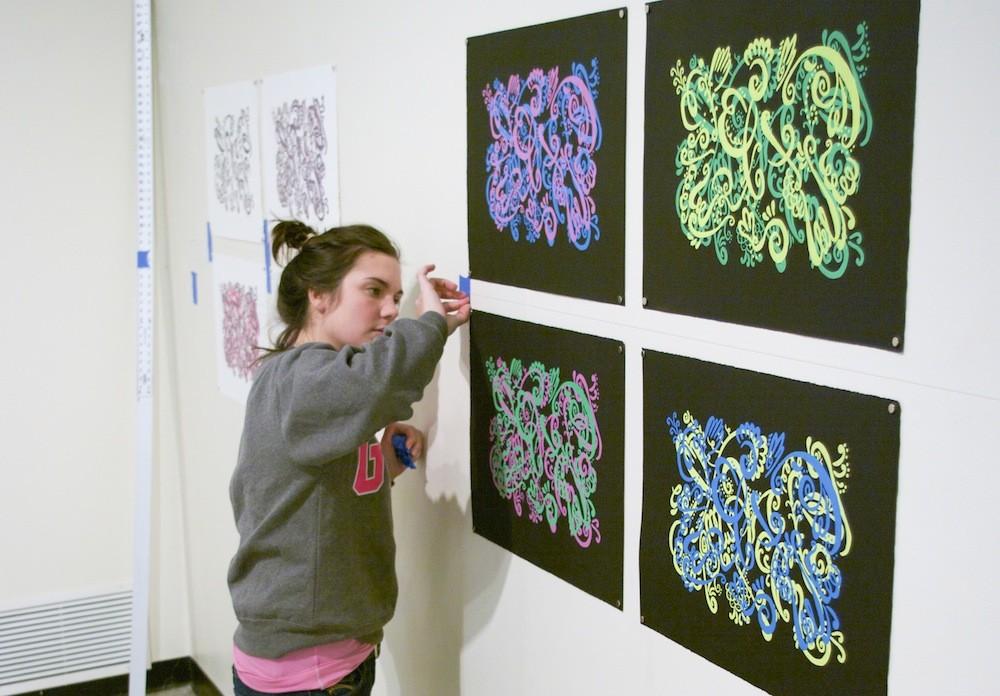Students ‘step forward in art education’

Courtesy Photo / Emily Horvat
Jan 24, 2013
Last November Emily Horvat and Michelle Haapala took a step forward in pursuing their art education degrees in a room filled with special needs children, their parents and as surplus of art supplies. The workshop was the first step in finding art for their gallery exhibit.
Now, through months of planning, hard work and sleepless nights, the Grand Valley State University seniors are showcasing what it means to be an art education student with “stepping forward in (ART) education.”
The exhibit, which is on display in the Padnos Gallery inside the Calder Art Center until Feb. 1., wasn’t required for graduation. They aren’t Bachelor of Fine Art students, but they’re pursuing Bachelor of Arts degrees and wanted a chance to showcase their years of hard work, just like the BFA students are required to do.
“At first, it was like, a kind of standing up for ourselves, like ‘We want to do this, we can do it,’” Haapala said. “I remember myself being outraged about, ‘Why can’t we do this too?’ And then it turned into, this is the perfect opportunity – if were getting this opportunity – this is a perfect opportunity to turn it about what we really are doing.”
Their original plan was to show people that art education wasn’t all about “boring lesson plans,” Haapala said, but they wanted people realize how much work actually goes into the degree. Students need at least 120 credits to graduate from GVSU, Horvat and Haapala will each have around 170.
“People don’t take us seriously sometimes, and I don’t know if people fully know the extent of what we fully do,” Haapala said. “That’s what started it.”
But after some thought, they’re real focus came into view. The gallery not only showcases their printmaking works, but also art created by 10 special education students, who Horvat worked with at a camp over the summer.
The November workshop let children with a range of disabilities create what they thought was gallery-worthy art. Each child started with a piece of white paper and were given crayons, markers and colored pencils, with the option of using other 3D elements, too. Horvat said most of the children stuck to only 2D drawings, and some just doodled on the paper, but others followed their direction to create pieces that they wanted to see in a gallery.
“They did what we told them to do, and we said ‘Just do it,’ Horvat said.
After several hours, and creating multiple projects, the children chose which pieces they wanted to hang in the gallery, with their name in large letters next to it.
“Some of them you could see made stuff that mimicked famous artists, or famous pieces,” Haapala said. “It’s cool to see their perceptions of what they would want to see in a gallery space because, hey now look at – it’s up in a gallery space.”
Haapala said they hope the children make the connection between their art and the gallery, and understand that, “Maybe it doesn’t have to be like ‘that’ to hang in a gallery.”
“It’s not like it’s some totally designer – I still think about that like, ‘My stuff can’t be in a show, it’s not worthy,’” Haapala said. “Yes it is, come on. Anything’s worthy.”
Both students want to teach elementary art, and the workshop and gallery process has helped them show what art education is really about.
“Art education is a lot, like, it’s all about community and bringing it out to the public, letting people know and educating people,” Haapala said.
They hope viewers will understand how passionate they are about teaching art to children, and it doesn’t matter what the final piece turns out to be, it’s still art.
“I tell people though, when they ask me what I want to do, I say, ‘I want to teach little kids to finger-paint,” Horvat said. “And people laugh, but that’s really want I want to do. I’m going to school for all this, and that’s really what I want to do – teach kindergarteners to finger-paint. I don’t care, I just want them to do it.”
They’ve invited the children with their families and teachers to come to the Jan. 31 reception, which runs from 5-7 p.m. and offers free Mexican food. Horvat said they’re excited to see the children’s reactions to their pieces displayed on the walls, along with hearing what the community thinks because the show is different than a typical art gallery.
“It’s not boring art, it’s kids art,” Horvat said.






















